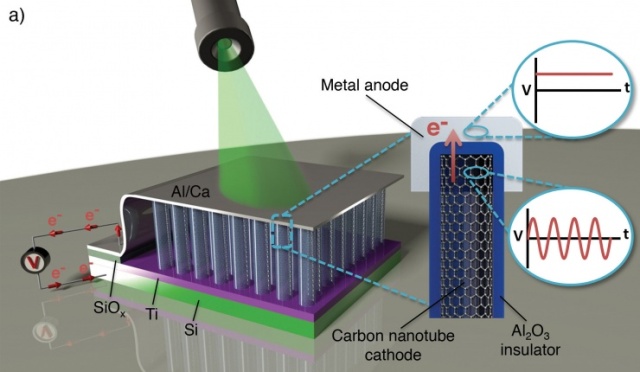Researchers Build Optical Rectennas Using Carbon Nanotubes and Tiny Rectifiers
Come: Chinese Academy of Sciences Date: 2015-12-04 11:55:13

The produced optical rectennas hold promise as photodetectors that do not require cooling and energy harvesters that could be used for conversion of waste heat to electricity. Their development could also lead to advancements in the efficiency of solar energy capture.
The carbon nanotubes in the devices function as antennas for capturing light. When the light waves strike the nanotube antennas, an oscillating charge is created that travels through the rectifier devices. A small direct current (DC) is created when due to the rectifiers switching on and off at record speeds on the petahertz scale.
A considerable amount of current is produced when an array is composed of billions of such rectennas. However, they demonstrate an efficiency of less than 1%. The team believes that optimization techniques could be used to increase the output and a commercially viable rectenna could be produced within a year.
We could ultimately make solar cells that are twice as efficient at a cost that is ten times lower, and that is to me an opportunity to change the world in a very big way
- Prof Baratunde Cola, Georgia Tech
Using nanometer-scale components, researchers have demonstrated the first optical rectenna, a device that combines the functions of an antenna and a rectifier diode to convert light directly into DC current.
Rectennas, developed in the 1960s and 1970s, have functioned at very short wavelengths of 10µm. Since then, researchers have been trying to create devices at optical wavelengths with great difficulty. The antennas had to be sufficiently small enough for coupling optical wavelengths and the rectifier diode had to have the ability to operate rapidly to capture electromagnetic wave oscillations. However, the low cost and potential high efficiency of a rectenna capable of capturing visible light caused researchers to continue their study.
The physics and the scientific concepts have been out there. Now was the perfect time to try some new things and make a device work, thanks to advances in fabrication technology.
- Prof Baratunde Cola, Georgia Tech
The team employed nanoscale fabrication techniques alongside metallic multiwall carbon nanotubes to build devices that utilized lights wave nature rather than its particle nature. The researchers observed that the device functioned within a temperature range of 5°C to 77°C.
In order to make the rectennas, the researchers grew forests of vertically aligned carbon nanotubes on a conductive substrate. Atomic layer chemical vapour deposition was used to in sulate the nanotubes with a coating of aluminum oxide. Optically transparent thin calcium layers were then deposited using physical vapor deposition over the nanotube forest. A potential difference of 2eV was achieved which is sufficient for ejecting electrons out of the carbon nanotube antennas upon the absorption of visible light.
Light in the form of oscillating waves interacts with nanotubes after going through the calcium-aluminum electrode. The nanotube tips have metal-insulator-metal junctions that work as rectifiers. These rectifiers switch on and off at time intervals in the femtosecond range. This means the electrons flow in one direction towards the top electrode. The 10nm diode functions at such a high frequency due to the ultra-low capacitance, which is in a few attofarads.
“A rectenna is basically an antenna coupled to a diode, but when you move into the optical spectrum, that usually means a nanoscale antenna coupled to a metal-insulator-metal diode. The closer you can get the antenna to the diode, the more efficient it is. So the ideal structure uses the antenna as one of the metals in the diode – which is the structure we made
- Prof Baratunde Cola, Georgia Tech
The rectennas were grown on rigid substrates however the team aims to grow rectennas on foil or other suitable materials for developing flexible photodetectors and solar cells. Cola intends to improve the efficiency of the rectennas in a number of ways such as changing materials, allowing multiple conduction channels in the carbon nanotubes, and reducing the structural resistance.
“We think we can reduce the resistance by several orders of magnitude just by improving the fabrication of our device structures,” “Based on what others have done and what the theory is showing us, I believe that these devices could get to greater than 40 percent efficiency.”
- Prof Baratunde Cola, Georgia Tech
< Previous Picoindenter measures CNT junction st...NASA Develop Spherical Occulter using... Next >